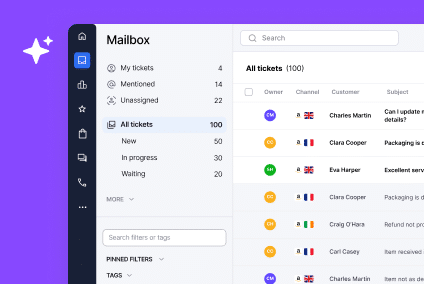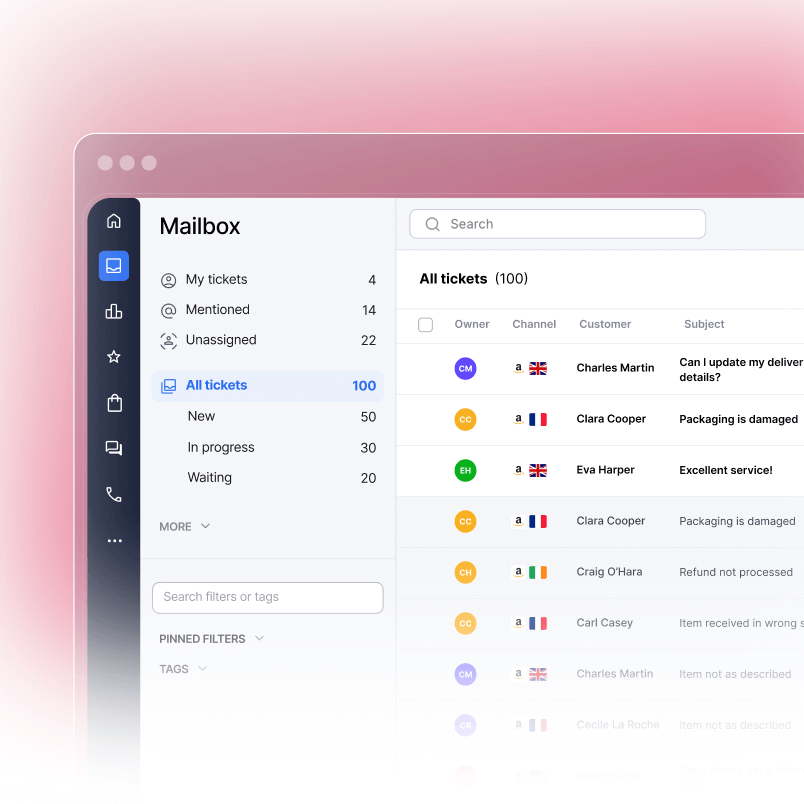When you enroll in Amazon FBA courses, you get the essentials. You learn product research. You study supplier sourcing and listing optimization. You dive into PPC advertising strategies. What you rarely hear about? The customer service muscle that actually protects your seller account and drives real revenue.
Here’s the truth most FBA courses skip: your sourcing skills mean nothing if you can’t manage buyer messages within Amazon’s strict timelines. Your perfect listing optimization crumbles if you rack up A-to-Z claims from frustrated customers. Your advertising spend becomes wasteful if negative feedback tanks your conversion rates.
This guide reveals the customer service gaps that cost sellers money. You’ll learn the compliance mistakes that trigger account suspension, the response time traps that destroy your seller rating, and the real-world scenarios that no online course covers. More importantly, you’ll get the tools and templates to fix these problems today.
What FBA Courses Focus On (and What They Miss)
Most Amazon FBA training programs follow a predictable formula. You get modules on finding winning products. You learn supplier vetting and negotiation tactics. You study how to optimize product titles, bullet points, and backend keywords. You master Amazon’s advertising system.
These topics matter. But they represent less than half the battle for long-term seller success.
The Critical Gaps in Standard FBA Education
Standard FBA courses rarely cover buyer message response time requirements. They skip the escalation protocols that separate 5-star sellers from suspended accounts. They don’t teach you how to audit your message templates for Amazon Terms of Service violations. They overlook the connection between your refund response speed and your Order Defect Rate, or ODR.
The courses also don’t explain the nuances of negative feedback removal. They don’t show you how to monitor your account metrics in real time. They don’t prepare you for the Saturday buyer who messages at 11 p.m. with a return request that Amazon counts as calendar days, not business days.
Meanwhile, these gaps directly impact your bottom line. Your seller rating depends on response times. Your Buy Box eligibility hinges on ODR. Your search rankings feel the ripple effects of poor buyer experience. Best FBA courses leave you unprepared for the customer service execution that makes or breaks your account.
The Real Impact of Customer Service on Your Account Health
You might think customer service is a necessary evil, something you handle after you’ve built your business. The opposite is true for Amazon sellers.
Response Time and Your Seller Rating
Amazon measures seller performance with precision. When a buyer messages you, the clock starts immediately. Amazon counts calendar days, not business days. If you miss the deadline, Amazon notes it. Enough missed responses lower your account health. Your seller rating suffers.
A lower rating doesn’t just hurt pride. It impacts your visibility in search results. It makes you ineligible for Prime placement. Brands lose the Buy Box to competitors with better ratings. Revenue drops.
The real impact shows up in your Amazon seller rating. Your rating influences which buyers trust your shop and which ones pass you by for competitors.
The Buy Box Connection
Winning the Buy Box means buyers see your offer first when they land on a product page. The Buy Box drives volume. Amazon considers seller metrics when awarding it, including response times and ODR. New FBA sellers sometimes assume they own the Buy Box because they handle fulfillment through Amazon. You don’t. You must earn it through consistent service performance.
Understanding your Amazon seller rating helps you see how closely your customer service connects to this outcome. Ignore service, and the Buy Box slips away.
Refund Response Speed and ODR Impact
ODR measures the percentage of orders that result in buyer complaints, negative feedback, A-to-Z claims, or chargebacks. Amazon requires sellers to maintain an Order Defect Rate below 1 percent. Sellers with higher defect rates face suspension risks and loss of account privileges.
When a buyer requests a return or refund, your response speed matters. Delay your refund, and the buyer escalates to A-to-Z claims. That’s counted against ODR. Your rating dips. Your account health declines.
The pattern repeats across buyer interactions. Each delayed message, each compliance violation, each unresolved dispute contributes to account pressure. Understanding your Amazon seller feedback patterns shows why this matters. Research from customer retention studies shows that 94% of shoppers expect quick responses within 24 hours, making response speed essential for retention and account health.
The 5 Most Common Customer Service Mistakes New FBA Sellers Make
New sellers make predictable errors that hurt their accounts. Understanding them now saves you months of recovery later.
Mistake 1: Ignoring Weekend Messages
This mistake costs sellers constantly. A buyer messages on Saturday. The seller sees it Monday morning. By then, the response deadline has passed.
Amazon counts calendar days. If you receive a message on Saturday, you have 24 hours to respond by Sunday. If you receive it on Sunday, Monday is your deadline. Most sellers don’t staff their inboxes on weekends. The result is missed deadlines that damage seller metrics.
The Fix: Set up autoresponders for off-hours. Use phrases like «Thanks for your message. We respond to all buyer inquiries within 24 hours.» This shows Amazon you’re engaged. You buy time to craft a thoughtful response before the deadline passes.
Mistake 2: Using Language That Violates Amazon Terms of Service
Amazon prohibits certain language in buyer-seller messages. Many new sellers don’t know the rules. They break them unknowingly.
For example, Amazon prohibits asking buyers to remove negative feedback in direct messages. It prohibits external communication requests. It prohibits reference to product quality issues that suggest the seller knew of defects. Violations trigger message removal, account warnings, or suspension.
Some sellers send messages like «Please remove your negative review and I’ll give you a refund.» Amazon flags this immediately. It looks like feedback manipulation.
The Fix: Audit every message template you use. Strip out references to feedback removal, external contact information, or anything that pressures the buyer. Stick to factual problem-solving language. «We’d like to resolve this issue for you» works. «Remove your review or we’ll do X» doesn’t.
Your message compliance depends on understanding Amazon buyer-seller messaging rules. This is where most courses fail sellers.
Mistake 3: Not Confirming Resolutions Through Buyer-Seller Messaging
Some sellers resolve issues outside Amazon’s system. They refund through a third party. They arrange replacements outside the message center. They assume Amazon sees the resolution.
Amazon doesn’t work that way. If the buyer doesn’t confirm resolution in the message thread, Amazon still counts the issue as open. The buyer files an A-to-Z claim. Your ODR increases. Your account takes a hit.
The Fix: Always confirm the resolution in the Buyer-Seller Message Center. Send a follow-up message when you’ve processed the refund. Ask the buyer to confirm receipt of the replacement. Close loops within Amazon’s system, not outside it.
Mistake 4: Delaying Refund or Return Responses
When a buyer initiates a return, timing matters. Amazon sets windows for return shipping. If the buyer doesn’t receive a refund decision quickly, they escalate.
Some sellers hope the issue will resolve itself. It doesn’t. The buyer opens an A-to-Z claim. Amazon sides with the buyer. Your account rating falls.
The Fix: Respond to return requests within 24 hours. Process refunds within the timeframe Amazon specifies in your return settings. Show evidence of action in the message center. Speed sends a signal that you care about resolution.
Understanding how Amazon FBA shipping and returns work helps you see why speed is critical. Returns are a major driver of disputes if mishandled.
Mistake 5: Not Monitoring Feedback in Real Time
Some sellers check their seller central dashboard weekly. Negative feedback sits for days. By then, the buyer has moved on or left additional negative comments.
Real-time feedback monitoring catches issues early. You respond before the feedback damages your rating further. You spot patterns across feedback. You find product issues before they tank your rankings.
The Fix: Log into your dashboard daily. Better yet, use notification tools that alert you the moment negative feedback appears. Respond within 24 hours with a solution-focused message.
Quick Fix Checklist
- Set up message alerts for off-hours
- Audit and revise all message templates for compliance
- Confirm every resolution inside the message center
- Process refunds within 24 hours of the request
- Check feedback every morning
Message Templates for High-Stress Buyer Situations
Real situations demand real scripts. These templates follow Amazon Terms of Service while showing empathy and competence.
Where Is My Order? (Delayed FBA Shipment)
«Thanks for reaching out. We understand the delay is frustrating. Your order [order number] shipped from our fulfillment center on [date]. Amazon’s tracking shows expected delivery by [date]. If it doesn’t arrive, please let us know and we’ll escalate this immediately with Amazon’s logistics team. We appreciate your patience.»
Item Not as Described
«We appreciate you giving us a chance to help. We want to make sure you’re satisfied with your purchase. We can arrange a return at no cost to you, or if you’d prefer, we’re happy to offer a partial refund. Which option works best for you?»
How Do I Return This?
«We make returns simple. You can start a return through your Amazon order page. Select the reason for return and print the label. Once Amazon receives the return, we’ll process your refund immediately. You should see the refund within 5-7 business days. Let us know if you have any issues with the return process.»
I Want a Refund But Already Left Negative Feedback
«Thank you for contacting us about a resolution. We take all concerns seriously. Please confirm what you need from us, whether that’s a refund, replacement, or exchange. We’ll handle this right away. Your feedback helps us improve. Once we’ve resolved this to your satisfaction, we’d welcome the opportunity to earn your trust going forward.»
Damaged Product Upon Arrival
«We’re sorry your item arrived damaged. That’s not the experience we want for you. We’ll send a replacement immediately at no charge, or process a full refund if you prefer. Please reply with your preference and we’ll get this sorted today.»
Using These Templates
These templates work because they acknowledge the buyer’s concern, offer clear solutions, and take action without delay. Customize them with real order numbers and dates. Add a personal touch. The buyer should feel heard, not like they’re talking to a bot.
Amazon rewards message clarity and speed. These templates deliver both. For more context on handling difficult situations, see how to turn around actively disengaged customers and transform angry customers into happy ones.
The Right Tools for Amazon Seller Support
You can manage buyer messages manually, but you’ll burn out. The right tools keep you organized, compliant, and fast. According to research on customer retention in ecommerce, 81% of customers say a positive support experience increases their likelihood of becoming repeat customers.
eDesk: Amazon-Native Inbox Management
eDesk specializes in FBA seller support. It centralizes all buyer messages in one dashboard. You see response time windows clearly. You get alerts when you’re approaching deadlines. You can set up autoresponders for off-hours.
The platform integrates directly with your Amazon account. It pulls order data into the message thread. You see what the buyer purchased, their return status, their account history. You handle issues faster because you have context.
eDesk also offers resolution timers that show you exactly how much time remains before deadlines pass. You’ll never miss a deadline by surprise again. It’s specifically designed for the Amazon seller workflow in ways off-the-shelf helpdesks aren’t.
FeedbackWhiz: Feedback Monitoring and Automation
FeedbackWhiz watches your feedback 24/7. The moment negative feedback lands, you get an alert. You can respond immediately.
The platform categorizes feedback by reason. You see patterns. If multiple buyers say the product arrived damaged, you investigate your packaging. If the issue is sizing, you know to update your description.
FeedbackWhiz also includes templates and scheduled messaging. You set up follow-ups to buyers who’ve received their items. You request feedback through compliant channels. The automation saves hours each month. Many sellers combine FeedbackWhiz with eDesk to cover both feedback and messaging comprehensively.
ChannelReply: Multi-Channel Management
If you sell on Amazon and other marketplaces, ChannelReply centralizes everything. It pulls messages from Amazon, eBay, Shopify, and other platforms into one inbox.
You manage buyer communication without switching between systems. You track response times across all channels. You apply consistent processes everywhere you sell.
Tool Comparison Reference
| Tool | Core Function | Response Time Alerts | Best For |
| eDesk | Amazon-native message management with compliance monitoring | Yes, visual timers | FBA sellers who want Amazon-specific compliance and speed |
| FeedbackWhiz | Feedback monitoring and analytics | Limited to feedback timing | Sellers who need deep feedback analysis and automated follow-up |
| ChannelReply | Multi-channel message consolidation | Yes, cross-platform | Multi-channel sellers who need unified inbox management |
Which tool fits your business depends on your scale and where you sell. New sellers focused solely on Amazon often start with eDesk. Established sellers across multiple platforms benefit from ChannelReply. All sellers benefit from feedback automation. If you sell across multiple platforms, explore our guide on multi-channel fulfillment and cost management.
What You Can Start Today
You don’t need to overhaul your entire operation tomorrow. You can implement these changes immediately.
Build Your Compliance Audit
Open your seller central dashboard. Go to your message center. Pull your last 10 outgoing messages. Read them out loud. Do they ask buyers to remove feedback? Do they include external contact details? Do they make promises about product quality that violate Amazon policy? Flag anything suspicious.
Rewrite flagged messages. Make them shorter, factual, and solution-focused. Save the new versions as templates.
Set Up Autoresponders for Off-Hours
Most FBA software includes autoresponder settings. Set up a simple message that fires when a buyer reaches out outside your active hours. «Thanks for your message. We respond to all inquiries within 24 hours.» That’s enough.
Configure Message Alerts
Most seller central allows email notifications. Enable them. Or better, use a tool like eDesk that sends real-time notifications to your phone. You won’t miss deadlines because you’ll see messages as they arrive.
Start Tracking Your Key Metrics
Log into seller central. Find your dashboard. Note your current ODR percentage, your response time rate, and your feedback count. Write these numbers down. They’re your baseline.
Check this dashboard every morning for two weeks. You’ll start seeing patterns. You’ll notice when messages pile up. You’ll understand your weakest time of day.
Create Your Escalation SOP
Write a simple one-page guide for yourself. It should cover how you handle returns, refunds, and damaged items. Include timelines. Include message templates. Include the tools you’ll use. Print it. Post it next to your desk.
When a difficult buyer message arrives, you won’t freeze. You’ll follow your SOP.
The difference between scaling successfully and struggling with account suspensions comes down to one thing: response time and compliance. Most FBA sellers realize too late that customer service isn’t something to handle later, it’s the foundation of everything else you build. When you move fast and respond consistently, Amazon rewards you with better visibility and higher conversion rates. Start today with these five steps, and watch your seller rating climb.
Ready to cut your response time in half and never miss a deadline again? Sign up for eDesk free today and get Amazon-native message management with built-in response time alerts. Your first 14 days are on us.
FAQs
Do Amazon FBA courses teach customer service?
Most standard FBA courses don’t cover customer service in depth. They focus on product research, sourcing, and marketing. Customer service gets a chapter or module at best, usually covering basic compliance rather than real-world scenarios. Sellers who succeed take additional training or learn through experience and tools designed for account management. Our guide on best Amazon FBA courses reviews what’s actually covered in the top programs.
What happens if I miss a buyer message deadline on Amazon?
Amazon tracks missed response deadlines. Missing one or two deadlines likely won’t cause immediate consequences. But patterns of missed deadlines lower your seller rating. Your ODR may increase. You become ineligible for certain benefits. Your account health score drops. You lose Buy Box priority. Revenue declines as a result.
Can I automate Amazon buyer messages?
You can use autoresponders for initial acknowledgment, which Amazon allows. You cannot fully automate responses to specific buyer concerns without violating policy. You can automate follow-up messages requesting feedback, but you must template those carefully to avoid policy violations. Tools like eDesk and FeedbackWhiz help you automate compliant parts of your workflow while you handle custom issues personally.
Which tools help manage Amazon customer experience best?
The best tool depends on your scale and sales channels. eDesk excels for FBA-focused sellers who need Amazon compliance and fast response management. FeedbackWhiz works well for sellers who need feedback analytics and automation. ChannelReply suits multi-channel sellers. Many successful sellers use a combination of tools. Start with one tool that matches your most urgent need, then add others as you grow. Our comparison of best eCommerce helpdesk software can help you evaluate options.
How long should I wait before responding to a buyer?
Amazon measures response time in hours from when the message arrives. You should aim to respond within 12 hours. This keeps you well under the 24-hour deadline. It shows Amazon you’re attentive. It prevents buyers from escalating to A-to-Z claims while waiting for your reply. Industry research shows that faster response times correlate with lower defect rates and better seller ratings.
What’s the difference between a refund request and an A-to-Z claim?
A refund request happens inside Amazon’s system through the message center or return process. The buyer gives you a chance to resolve the issue. An A-to-Z claim is filed when a buyer believes you’ve failed to resolve their problem. Amazon then investigates and makes the decision. A-to-Z claims count against your ODR. Refund requests don’t, unless you mishandle them. Quick, compliant responses to refund requests prevent A-to-Z claims.
Should I respond to negative feedback immediately?
Yes. Amazon allows sellers to respond to negative feedback publicly. Responding within 24 hours shows you’re engaged. You can’t ask the buyer to remove the feedback, but you can explain your side or offer to resolve the issue. A thoughtful response shows other buyers that you take concerns seriously. This limits the damage negative feedback does to your conversion rate. Learn the advantages of responding thoughtfully to negative feedback.
How do I know if my messages violate Amazon policy?
Review Amazon’s Buyer-Seller Messaging Policy directly in seller central. Avoid asking for feedback removal, external contact info, or anything that sounds like pressure. Don’t make claims about product quality that suggest you knew of defects. Don’t offer refunds conditioned on feedback changes. When in doubt, stick to factual problem-solving language. Use the templates provided in this guide. You can also audit messages with tools like eDesk that flag policy violations. For more detail, see our guide on Amazon Terms of Service for sellers.
What metrics should I track as an FBA seller?
Track Order Defect Rate, response time percentage, and negative feedback count. These three metrics directly impact account health. Also track refund rate and return rate. If both climb, you have a product or description problem. Track your feedback categories to spot patterns. Monitor your Buy Box percentage if you compete with other sellers. These metrics tell the story of your customer experience performance. Understanding your seller metrics helps you identify problem areas quickly.
How often should I check my seller dashboard?
Check it daily if you can, or at least three times per week. Daily checks catch issues early. You spot feedback immediately. You see message alerts before deadlines pass. You notice patterns faster. If daily isn’t realistic, set a calendar reminder to check every Monday, Wednesday, and Friday morning. Consistent monitoring beats sporadic urgency.




